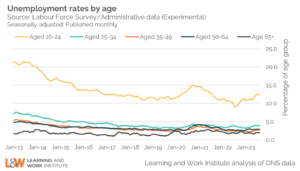October 2023
This month’s data release is more limited than usual due to uncertainties created by falling response rates to the Labour Force Survey. The ONS has released a more limited set of data, adjusted in line with trends in administrative data like HMRC PAYE data and the claimant count of unemployed people. However, these administrative data have their own challenges. Significant caution should therefore be exercised in the use of these statistics until a new Labour Force Survey and revised population projections are in place in 2024.
Sign up for our online Employment and Skills Summit

1. Headline indicators
Employment in August is up by 9,000 on the previous month but down by 59,000 on the March-May 2023 quarter, to 31,554,000. The employment rate for those aged 16-64 was 75.7%. down by 0.3 percentage points compared with the last quarter.
Economic inactivity for those aged 16-64 is up by 74,000 on the previous quarter to 8.7 million. The economic inactivity rate increased by 0.1 percentage points to 20.9%.
Unemployment (for those aged 16-64) rose by 69,000 compared with the previous quarter, which is equivalent to a 0.2 percentage point increase in the rate to 4.3%.
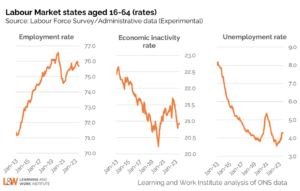
2. Real wages rose slightly as inflation slows, but remain well below pre-financial crisis trends
The latest data show average regular earnings grew by 7.8% in the year to August 2023. For public sector workers average regular earnings grew by 6.8%, while average regular earnings grew by 8.0% for private sector workers. The slowing rate of inflation means real regular earnings went up by 1.1% (3-month average change) in the year to August 2023, with the single month data for August showing an increase of 1.3% over the year. Inflation has remained largely unchanged in recent months – CPIH decreased very slightly from 6.4% in July to 6.3% in August and stayed at 6.3% in September. Core CPIH (excluding energy, food, alcohol and tobacco) in the year to August 2023 was 5.9%, down from 6.4% in July. It remained at 5.9% in the year to September 2023. Also, inflation in areas like food and non-alcoholic beverages is still very high. Inflation in the UK remains above that in other countries in the G7. The United States is currently experiencing an inflation rate of 3.7% while the Eurozone average is currently 4.3%. Weak growth since the global financial crisis means average earnings are around £12,000 per year lower than if pre-crisis trends had continued.
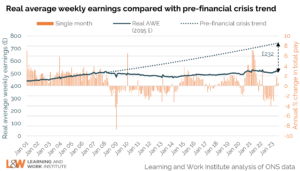
3. There are fewer potential workers for employers to recruit, with 604,000 fewer over 50s in the labour market since the pandemic started
Recruitment has been more challenging for employers since the pandemic because of rises in economic inactivity – people leaving the labour market. The number of people aged 50-64 who are economically inactive has increased by 8.4% since the pandemic started.
Economic inactivity has been fairly stable in the most recent quarter, with a rise of just 0.1 percentage points in June to August 2023 compared with March to May 2023. But the challenge remains: the number of those aged 16-64 who are economic inactive is 355,000 higher than pre-pandemic, yet only one in ten out-of-work older people and disabled people get employment support each year. The Government needs to extend employment support to more people outside the labour market and employers need to think about recruitment and job design to attract and retain staff.
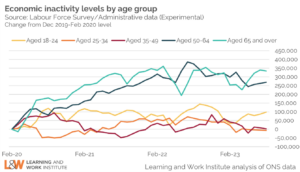
4. Vacancies are falling, but remain high by historic standards
Headline vacancies this month remain unchanged at 988,000 but are down by 64,000 compared with the previous quarter. The ONS’ experimental single-month vacancy figure has risen by 54,000 over the past month. The headline ONS vacancy figure is both seasonally adjusted and a three-month average.
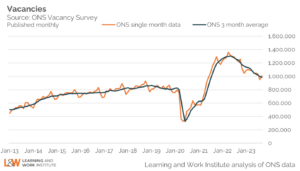
5. Numbers claiming unemployment-related benefits continue to exceed ILO measure of unemployment
Adjustments to the Labour Force Survey to align with other sources mean that the sizeable gap between the numbers claiming unemployment-related benefits and those unemployed on the official measure has narrowed considerably this month. Unemployment is 1,444,000, up by 4,000 from last month’s published level, and the quarterly headline figure has risen by 74,000. The ONS figure for claimant unemployed was 1,541,000 in August, down by 9,000 on the previous month and up by 15,000 on the quarter. In August 2023 the number of unemployed people who were claiming unemployment-related benefits was 86,000 higher than the number unemployed on the official measure.
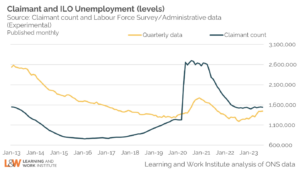
6. Unemployment rate much higher for young people than for those aged 25+
The 16- to 24-year-old unemployment rate (including students) is 12.5% of the economically active. The rate for those aged 25 to 49 is 3.2%. For those aged 50 and over it is 2.8%. The quarterly change is an increase of 1.1 percentage points for 16- to 24-year-olds and increases of 0.1 percentage points for both 25 to 49 year olds and the over-50s.
